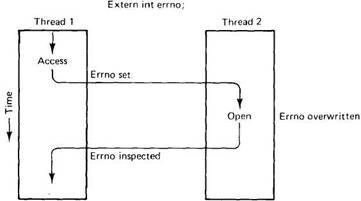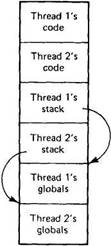Книга: Distributed operating systems
4.1.3. Design Issues for Threads Packages
4.1.3. Design Issues for Threads Packages
A set of primitives (e.g., library calls) available to the user relating to threads is called a threads package. In this section we will consider some of the issues concerned with the architecture and functionality of threads packages. In the next section we will consider how threads packages can be implemented.
The first issue we will look at is thread management. Two alternatives are possible here, static threads and dynamic threads. With a static design, the choice of how many threads there will be is made when the program is written or when it is compiled. Each thread is allocated a fixed stack. This approach is simple, but inflexible.
A more general approach is to allow threads to be created and destroyed on-the-fly during execution. The thread creation call usually specifies the thread's main program (as a pointer to a procedure) and a stack size, and may specify other parameters as well, for example, a scheduling priority. The call usually returns a thread identifier to be used in subsequent calls involving the thread. In this model, a process starts out with one (implicit) thread, but can create one or more threads as needed, and these can exit when finished.
Threads can be terminated in one of two ways. A thread can exit voluntarily when it finishes its job, or it can be killed from outside. In this respect, threads are like processes. In many situations, such as the file servers of Fig. 4-3, the threads are created immediately after the process starts up and are never killed.
Since threads share a common memory, they can, and usually do, use it for holding data that are shared among multiple threads, such as the buffers in a producer-consumer system. Access to shared data is usually programmed using critical regions, to prevent multiple threads from trying to access the same data at the same time. Critical regions are most easily implemented using semaphores, monitors, and similar constructions. One technique that is commonly used in threads packages is the mutex, which is a kind of watered-down semaphore. A mutex is always in one of two states, unlocked or locked. Two operations are defined on mutexes. The first one, LOCK, attempts to lock the mutex. If the mutex is unlocked, the LOCK succeeds and the mutex becomes locked in a single atomic action. If two threads try to lock the same mutex at exactly the same instant, an event that is possible only on a multiprocessor, on which different threads run on different CPUs, one of them wins and the other loses. A thread that attempts to lock a mutex that is already locked is blocked.
The UNLOCK operation unlocks a mutex. If one or more threads are waiting on the mutex, exactly one of them is released. The rest continue to wait.
Another operation that is sometimes provided is TRYLOCK, which attempts to lock a mutex. If the mutex is unlocked, TRYLOCK returns a status code indicating success. If, however, the mutex is locked, TRYLOCK does not block the thread. Instead, it returns a status code indicating failure.
Mutexes are like binary semaphores (i.e., semaphores that may only have the values 0 or 1). They are not like counting semaphores. Limiting them in this way makes them easier to implement.
Another synchronization feature that is sometimes available in threads packages is the condition variable, which is similar to the condition variable used for synchronization in monitors. Each condition variable is normally associated with a mutex at the time it is created. The difference between mutexes and condition variables is that mutexes are used for short-term locking, mostly for guarding the entry to critical regions. Condition variables are used for long-term waiting until a resource becomes available.
The following situation occurs all the time. A thread locks a mutex to gain entry to a critical region. Once inside the critical region, it examines system tables and discovers that some resource it needs is busy. If it simply locks a second mutex (associated with the resource), the outer mutex will remain locked and the thread holding the resource will not be able to enter the critical region to free it. Deadlock results. Unlocking the outer mutex lets other threads into the critical region, causing chaos, so this solution is not acceptable.
One solution is to use condition variables to acquire the resource, as shown in Fig. 4-5(a). Here, waiting on the condition variable is defined to perform the wait and unlock the mutex atomically. Later, when the thread holding the resource frees it, as shown in Fig. 4-5(b), it calls wakeup, which is defined to wakeup either exactly one thread or all the threads waiting on the specified condition variable. The use of WHILE instead of IF in Fig. 4-5(a) guards against the case that the thread is awakened but that someone else seizes the resource before the thread runs.

Fig. 4-5. Use of mutexes and condition variables.
The need for the ability to wake up all the threads, rather than just one, is demonstrated in the reader-writer problem. When a writer finishes, it may choose to wake up pending writers or pending readers. If it chooses readers, it should wake them all up, not just one. Providing primitives for waking up exactly one thread and for waking up all the threads provides the needed flexibility.
The code of a thread normally consists of multiple procedures, just like a process. These may have local variables, global variables, and procedure parameters. Local variables and parameters do not cause any trouble, but variables that are global to a thread but not global to the entire program do.
As an example, consider the errno variable maintained by UNIX. When a process (or a thread) makes a system call that fails, the error code is put into errno. In Fig. 4-6, thread 1 executes the system call ACCESS to find out if it has permission to access a certain file. The operating system returns the answer in the global variable errno. After control has returned to thread 1, but before it has a chance to read errno, the scheduler decides that thread 1 has had enough CPU time for the moment and decides to switch to thread 2. Thread 2 executes an open call that fails, which causes errno to be overwritten and thread 1's access code to be lost forever. When thread 1 starts up later, it will read the wrong value and behave incorrectly.

Fig. 4-6. Conflicts between threads over the use of a global variable.
Various solutions to this problem are possible. One is to prohibit global variables altogether. However worthy this ideal may be, it conflicts with much existing software, such as UNIX. Another is to assign each thread its own private global variables, as shown in Fig. 4-7. In this way, each thread has its own private copy of errno and other global variables, so conflicts are avoided. In effect, this decision creates a new scoping level, variables visible to all the procedures of a thread, in addition to the existing scoping levels of variables visible only to one procedure and variables visible everywhere in the program.

Fig. 4-7. Threads can have private global variables.
Accessing the private global variables is a bit tricky, however, since most programming languages have a way of expressing local variables and global variables, but not intermediate forms. It is possible to allocate a chunk of memory for the globals and pass it to each procedure in the thread, as an extra parameter. While hardly an elegant solution, it works.
Alternatively, new library procedures can be introduced to create, set, and read these thread-wide global variables. The first call might look like this:
create_global("bufptr");
It allocates storage for a pointer called bufptr on the heap or in a special storage area reserved for the calling thread. No matter where the storage is allocated, only the calling thread has access to the global variable. If another thread creates a global variable with the same name, it gets a different storage location that does not conflict with the existing one.
Two calls are needed to access global variables: one for writing them and the other for reading them. For writing, something like
set_global("bufptr", &buf);
will do. It stores the value of a pointer in the storage location previously created by the call to create_global. To read a global variable, the call might look like
bufptr = read_global("bufptr");
This call returns the address stored in the global variable, so the data value can be accessed.
Our last design issue relating to threads is scheduling. Threads can be scheduled using various scheduling algorithms, including priority, round robin, and others. Threads packages often provide calls to give the user the ability to specify the scheduling algorithm and set the priorities, if any.
- Advanced OS Design Configurations
- OS Design Settings
- 1.5. DESIGN ISSUES
- Forced writes - палка о двух концах
- Forced Writes
- Chapter 15. Graphical User Interfaces for Iptables
- What NAT is used for and basic terms and expressions
- Information request
- SCTP Generic header format
- System tools used for debugging
- FORWARD chain
- How to use this License for your documents




